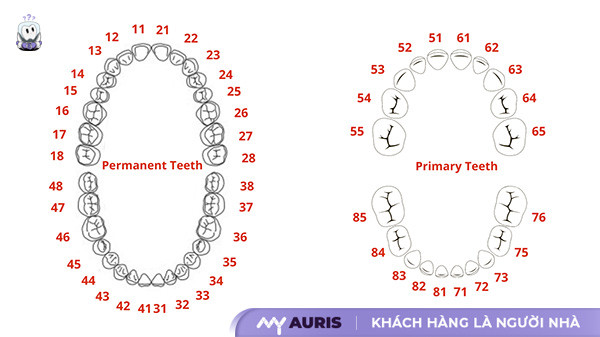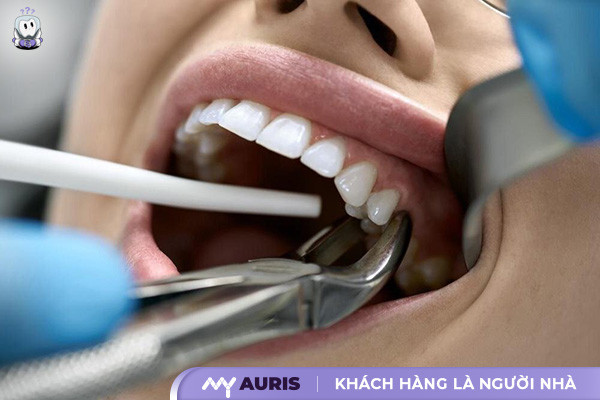The 6th molar is one of the first permanent molars to appear early in a child’s dental arch, typically erupting at 6-7 years of age. This tooth plays a crucial role in chewing food and contributes to the comprehensive development of a child’s dentition. To protect their children’s oral health, parents need to be aware of the importance of the 6th molar and proactively take their children for regular dental check-ups. Follow the next article for more useful information from leading dental experts!
What is the 6th Molar?
The 6th molar is the first large molar in the dental arch, also known by common names such as the “forbidden tooth” or “grinding tooth.” It is the first large tooth in the jaw, primarily responsible for daily food chewing. According to dental anatomy, the 6th molar erupts at the sixth position in the jaw, counting inwards from the central incisor. This tooth is adjacent to the 7th molar and usually becomes stable when a child is between 6 and 7 years old.

Structure of the 6th Molar
The structure of the 6th molar includes two main parts: the crown and the root, connected by a line called the “cementoenamel junction.” When viewed from the outside in, the 6th molar has three important layers: enamel, dentin, and pulp.
Pulp
The pulp is the innermost part of the tooth, containing pulp canals and blood vessels that help circulate and transport nutrients to nourish the tooth effectively, maintaining the health of the 6th molar.
Enamel
Enamel is the hardest structure in the tooth, consisting of up to 96% inorganic salts. It is quite hard, brittle, and X-ray resistant. This enamel layer is very thin and translucent; when observed, the underlying dentin with its characteristic yellowish-white color is visible. Enamel covers the tooth crown unevenly, being thickest at the cusp tips (over 1.5mm) and thinner at the neck of the tooth.
Dentin
Dentin accounts for most of the tooth crown’s mass and is covered by enamel. Its main function is to protect the inner pulp. Compared to enamel, dentin is softer, more elastic, and less prone to breakage. The color of dentin is usually pale yellow with a somewhat porous structure. Inside the dentin are nerve endings, making it very sensitive to hot and cold temperatures from the surrounding environment.
Functions of the 6th Molar
Ensuring efficient chewing function: The 6th molar plays a vital role in chewing function, as most chewing force is concentrated on it. This tooth helps grind food into small pieces, facilitating the digestion process. When the 6th molar is lost, chewing ability is severely affected, causing food not to be thoroughly ground before swallowing. This makes the stomach work harder to digest food, easily leading to stomach pain, negatively impacting the digestive system, and reducing nutrient absorption.
Clear pronunciation: The 6th molar also contributes to pronunciation by creating sounds during speech. The loss of the 6th molar can reduce pronunciation clarity, causing difficulties in daily communication.
Forming a stable bite: The 6th molar helps define the bite structure. As the permanent molars erupt, the 6th molar acts as a stable support, helping prevent crowded or misaligned teeth, thereby avoiding an uneven bite.
Supporting a balanced facial structure: Each tooth plays a role in maintaining the balance of the jaw and face. Long-term loss of the 6th molar will lead to sunken cheeks and sagging facial muscles, accelerating the aging process compared to actual age, affecting aesthetics and facial structure.

Guide to Caring for a Strong 6th Molar
To keep your 6th molars strong, you need to implement proper protective and health maintenance measures daily. Daily care is crucial, including brushing teeth twice a day, especially in the morning upon waking and at night before bed. Apply a scientific brushing method by brushing from top to bottom or using a circular motion to clean all tooth surfaces, preventing bacterial growth.
Additionally, it is advisable to use auxiliary tools such as a water flosser or dental floss to effectively clean between teeth, combined with rinsing with physiological saline to keep the mouth cleaner and prevent oral diseases. Tongue cleaning is also essential; don’t forget to brush your tongue every time you brush your teeth to remove plaque on the tongue, contributing to improved breath and overall oral health.
Fluoride supplementation is an important measure not to be overlooked; choose toothpaste containing fluoride to protect teeth from bacterial attacks that cause cavities and other damage. Finally, regular dental check-ups every 6 months are essential for a comprehensive oral health check, early detection of issues with the 6th molar, and timely treatment, ensuring teeth remain strong and beautiful over time.
Answers to Frequently Asked Questions about the 6th Molar
How many roots does the 6th molar have?
The number of roots of the 6th molar depends on its position in the jaw. Specifically, the upper 6th molars (including teeth 16 and 26) typically have 3 strong roots, which effectively support chewing forces. In contrast, the lower 6th molars (teeth 36 and 46) only have 2 roots due to the different structure of the lower jaw, but still ensure stable chewing function.
How many pulp canals does the 6th molar have?
The 6th molar is known for having the most pulp canals among all teeth. Each 6th molar usually has at least 3 pulp canals, and can have up to 5 canals depending on the individual. This is why root canal treatment on the 6th molar requires meticulousness and high expertise from the dentist to ensure thorough and safe treatment.
At what age do children get their 6th molars?
The 6th molar usually erupts when children are around 6-7 years old and only appears once in a lifetime. Because it emerges during a critical developmental stage, many parents easily mistake the 6th molar for a baby tooth, leading to a lack of proper dental care. This situation creates conditions for bacteria to develop, causing diseases such as tooth decay, gingivitis, and even tooth loss.
Does the 6th molar get replaced?
The 6th molar is a permanent tooth; it appears only once in a lifetime and is completely different from baby teeth as it does not have a replacement stage. Losing the 6th molar causes many undesirable consequences because this tooth cannot grow back after loss, directly affecting chewing function and overall oral health. Therefore, caring for and protecting the 6th molar from when it erupts is very important to avoid serious problems later on.

Can the 6th molar be extracted?
The decision of whether the 6th molar can be extracted is based on X-ray results and the current oral health condition of each individual.
Cases where lower 6th molar extraction is not recommended
If the tooth has mild decay, is not loose, or has mild pulpitis, it should be preserved. In this situation, the dentist will perform a filling or crown to help the tooth recover and protect it from harmful bacteria.
Cases where 6th molar extraction is necessary
When the tooth is severely damaged, only a root remains, the tooth is extensively fractured, or the root is loose and cannot be restored, the 6th molar needs to be extracted. If not extracted, the condition will affect adjacent teeth, causing bone abscesses in the tooth socket, bone loss, and many other dangerous complications.
To rehabilitate the 6th molar after extraction, the dentist will perform an Implant placement, which minimizes impact and harm to natural teeth, ensuring chewing function and aesthetics for the patient.
Does the 6th molar grow back after extraction?
This is a common question because the 6th molar only erupts once in a lifetime and does not get replaced. Therefore, when a 6th molar is extracted, it does not grow back, leading to long-term consequences for oral health.
Is losing the 6th molar dangerous?
The 6th molar helps maintain effective jawbone development. When the 6th molar is lost, chewing force significantly decreases, leading to gradual jawbone resorption over time. This condition can result in many serious complications such as subsequent tooth loss, premature aging, and sagging skin, negatively affecting aesthetics and chewing function. Therefore, protecting the 6th molar and addressing its loss promptly is crucial to maintaining overall dental health.
The 6th molar plays an essential role in grinding food and maintaining the stability of the dental arch. You should brush your teeth at least twice a day and have regular dental check-ups every 6 months to detect common problems with the 6th molar, such as cavities, chips, or cracks, early on, and to allow for timely and effective treatment. This will not only help protect your 6th molar but also contribute to enhancing your quality of life.





